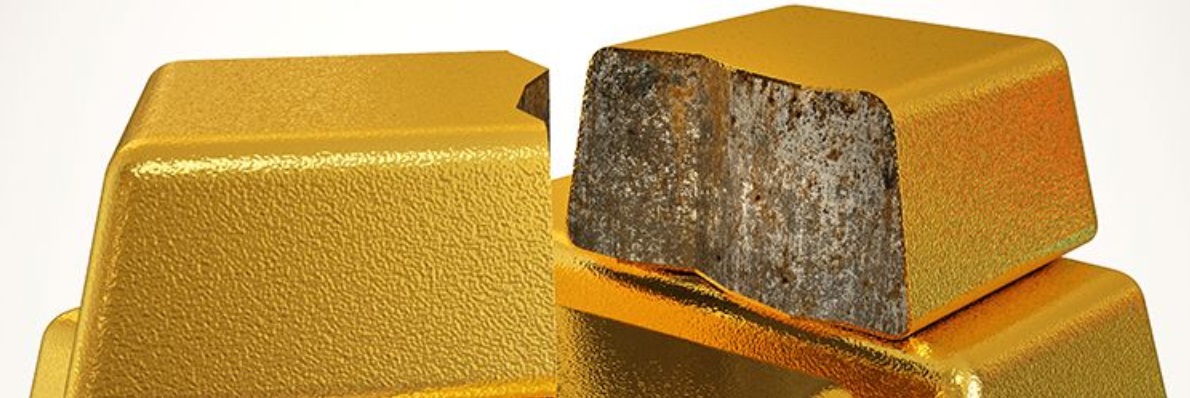Techniques for Identifying Fake Gold Bars
Destructive & Non-Destructive Tests to Confirm the Purity of Gold Bars:
Trading in gold bars always carries some risks regarding purity, and “fake” ingots.
One of the common ways to forge ingots is by using a bar containing a tungsten core. Since tungsten (Wolfram) has the same density as gold, 19.3g/cm³, ingot size does not change. Forging gold bars with tungsten can beidentify using ultrsound test as a non destractive test or by remelting as a destractive test. some other fake gold may be fake by lower karat of gold plating.
Befor we dive into the techniques just take note of the 4 steps that should be done as a
STANDART ASSAY PROTOCOL:
- Generl test- weigth, veiwing the ingot/coin, magnet
- Surface assay-XRF , acid test etc.
- Density test- Arcimedes principle
- Bulk test- Digital Ultrasonic Thickness Gauge or similar
In this article we will try to review the various techniques that may help us to detect fakes:
Non-Destructive Methods
- Acid Test – An old, fast and cheap test:
In this test, we scratch the bar on a special stone to make a gold colored line color and place one drop of acid on the line. If the gold color does not disappear – then it is real gold. (There are different acids for each Karat from 6K to 24K)
Order on Amazon
- Magnetic test:
Gold is a diamgnetic metal , which is amost inert to even strong magnet as neodymium magnet. By moving a neodymium magnet horizental to gold item surface we can feel the gravitybetween the magnet and the item which can be a hint for a fake gold.
To buy a strong magnet on Amazon.
- XRF – (handheld and benchtop) analyzers:
These became very popular over the last decade. In this fast and accurate high-tech method, coins or bars are exposed to X-rays and the reflecting X-ray fluorescence radiation is analyzed. We can then determine the metallic composition of the object precisely and reliably. As with the acid test, the disadvantage of this quick test method is its limitation to testing only the object’s surface. If the layer of gold coating of a fake bullion is thick enough, the X-ray fluorescence analysis would return a false positive.
Note: Our recommendations for handheld XRF, after years of use, are the Niton XL3 GOLDD + and the Hitachi X-Met 8000.
- LIBS – Laser Induced Breakdown Spectrograph:
This new technology, which competes with the XRF, is an excellent tool for verifying a material’s content. LIBS has the advantages of having no radiation and less regulation compared to the XRF.
However, similarly to the XRF, it can test only the surface of the bar and gives no data about the core material. Its price is very similar to the price of XRF and starts at ~$20,000.
- Density check via water displacement:
This test method has been around for a very long time: the Greek mathematician and physicist Archimedes developed it in the 3rd century BC. The density of the bar or coin is determined by immersing it in water and measuring the amount of water displaced. Archimedes discovered that every metal has a specific weight; that of 24 carat gold with a fineness of 999.9/1000 is 19.3 g/cm^3. A great advantage of this method is that, in addition to authenticity, the fineness of gold can also be reliably determined.
However, extreme accuracy is required; even the water temperature must be exactly 20° Celsius, because only then is the density of water exactly 1 g/cm^3. In addition, the test object must also be completely smooth all around, since even the smallest water bubbles can influence the result.
Since density = weight/volume, the water displaced presents the volume and it becomes easy to calculate the density of the bar. This technique will not be helpful with large bars forged with tungsten, but it could come in useful for small bars, where tungsten use is difficult.
Measuring density is simple with the “Solid Density Volumetric Electronic Hydrostatical Balance Scale”. For more information click on this button
- Ultrasound test:
Using an ultrasonic measuring instrument, we can determine whether the gold bars are homogenous or whether they contain additions or different materials such as a tungsten core.
You may try CAMWAY Digital Ultrasonic Thickness Gauge
- Conductivity measurement:
Performed using the “Eddy Current Principle” and measuring the conductivity of the metal. Fischer company designed a simple and easy tool – (“Sigmascope Gold Tester”) to verify the authenticity of a wide range of gold items. For more information click on this button - GemOro AGT3:
A small and portable handheld verification instrument for gold & platinum testing, tests all colors of gold from 6K to 24K.
For more information click on this button
Destructive Methods
Using destructive tests we stand to gain much more certainty and the chance for mistakes is almost not existent. The downside is we ruin the bar.
- Cutting in the middle: Using a guillotine to cut the bar and then assaying it with XRF (at the cut edges or by drilling the cut edge).
For more information click on this button for a Guillotine metal shear
- Drilling the ingot from top to bottom: Drilling the ingot and assaying the turnings (it’s better to drill in more than one point).
- Recasting the ingot, sample and assay: This tool gives 100% certainty and is used by many refiners. The best way to recast is by using an induction furnace, but it is also possible to use an electronic smelting furnace. For more information click on this button
Note: Usually when trading gold bars & coins, we prefer to use a nondestructive test. A.G. Metals recommends assaying the surface purity by XRF and then using an ultrasonic or conductive test to ensure homogeneity. Another little tip à do business with honest people.
Below some photos of common tools for identifing fake GOLD
for more details press MORE

How to Estimate Gold Content in Gold Plated Parts
When trading electronic scrap or jewelry, we sometimes have to quote plated materials

Advantages of Investing in Gold Bullions Bars & Coins
A bullion is a precious metal in the form of a bar ingot or coin, with a purity of at least 99.95% or 99.99%



